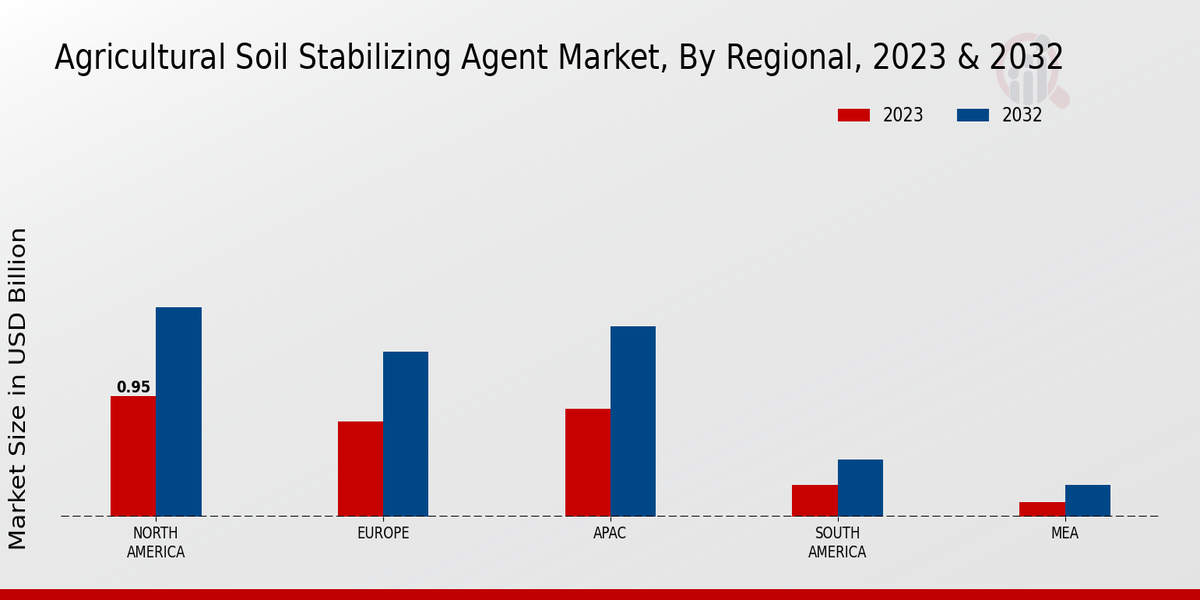Government Initiatives and Support
Government policies and initiatives aimed at promoting sustainable farming practices are playing a crucial role in the Global Agricultural Soil Stabilizing Agent Market Industry. Various governments are implementing programs that encourage the use of soil stabilizing agents to improve soil health and agricultural productivity. For instance, subsidies and financial incentives for farmers adopting these agents are becoming more common. Such initiatives not only enhance soil stability but also contribute to food security. As governments worldwide recognize the importance of sustainable agriculture, the market is expected to benefit from increased funding and support, fostering growth in the sector.
Increasing Awareness of Soil Health
There is a growing awareness among farmers and agricultural professionals regarding the importance of soil health, which is positively impacting the Global Agricultural Soil Stabilizing Agent Market Industry. Educational programs and workshops are being organized to inform stakeholders about the benefits of soil stabilizing agents in enhancing soil fertility and crop productivity. This heightened awareness is leading to increased adoption rates of these agents, as farmers recognize their potential to improve yields and reduce input costs. As soil health becomes a focal point in agricultural practices, the demand for stabilizing agents is expected to rise, further propelling market growth.
Global Population Growth and Food Demand
The continuous growth of the global population is exerting pressure on agricultural systems to produce more food, thereby driving the Global Agricultural Soil Stabilizing Agent Market Industry. With the world population projected to reach approximately 9.7 billion by 2050, the demand for efficient agricultural practices is paramount. Soil stabilizing agents play a vital role in enhancing soil productivity and resilience, enabling farmers to meet the increasing food demand. As agricultural practices evolve to accommodate this growth, the market for soil stabilizing agents is anticipated to expand significantly, with projections indicating a market value of 6.35 USD Billion by 2035.
Rising Demand for Sustainable Agriculture
The Global Agricultural Soil Stabilizing Agent Market Industry is experiencing a notable surge in demand driven by the increasing emphasis on sustainable agricultural practices. Farmers and agricultural stakeholders are increasingly adopting soil stabilizing agents to enhance soil quality and reduce erosion. This shift is particularly evident in regions where soil degradation poses significant challenges to crop yields. The market is projected to reach 3.29 USD Billion in 2024, reflecting a growing awareness of the environmental impact of traditional farming methods. As sustainability becomes a priority, the adoption of soil stabilizing agents is likely to accelerate, contributing to the overall growth of the industry.
Technological Advancements in Soil Stabilization
Innovations in soil stabilization technologies are significantly influencing the Global Agricultural Soil Stabilizing Agent Market Industry. The development of advanced formulations and application techniques is enhancing the effectiveness of soil stabilizing agents. For example, the introduction of bio-based stabilizers and nanotechnology is improving soil structure and nutrient retention. These advancements are likely to attract more farmers seeking efficient solutions to soil-related challenges. As the industry evolves, the integration of technology is expected to drive market growth, with projections indicating a compound annual growth rate of 6.16% from 2025 to 2035, reflecting the potential for continued innovation.











